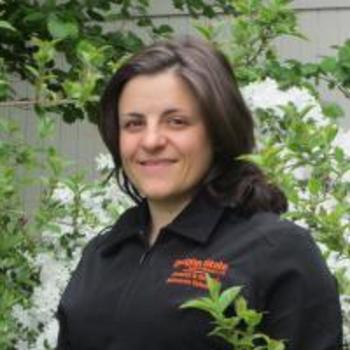- You can protect yourself and your family by preparing for a wildfire smoke event.
- If you or your family have been exposed to smoke and are experiencing severe symptoms, like difficulty breathing or chest pain, call 911 or go to the emergency room immediately.
Wildfire smoke is a mix of gases, water vapor and small particles from burning trees, plants, buildings and other material. Breathing in wildfire smoke can hurt your health. Older adults, children, pregnant women and people with asthma, lung disease, or heart disease are especially at risk. You can take simple steps now to protect yourself and your family from wildfire smoke.
How can wildfire smoke affect you?
Particulate matter, or PM, is a mix of tiny solid particles and liquid droplets in the air we breathe. Some particulate matter, like smoke, dust or dirt, is large enough to see. Fine particulate matter (PM2.5) is so tiny — narrower than a single hair from your head — it passes through the nose and throat and enters the lungs. Once inhaled these particles can affect the lungs and heart and cause serious health effects.
Wildfire smoke can also cause:
- Watery or dry eyes
- Persistent cough, phlegm, wheezing, scratchy throat or irritated sinuses
- Headaches
- Fatigue
- Mental health-related effects like depression or anxiety
- Shortness of breath, asthma attacks or lung irritation
- Irregular heartbeat or chest pain
- Heart attacks
What is the Air Quality Index?
The Air Quality Index is a tool for reporting daily air quality. AQI values range from 0 to 500. The higher the number, the greater the level of air pollution and the greater the health concern. When AQI values are above 100, air quality is unhealthy for sensitive groups. Above 150, it is harmful for everyone. It’s a good idea to stay informed about air quality levels during a wildfire to limit your exposure to smoke.Do your best to be informed about air quality in your community. If you have a smartphone or a tablet, you can download the free OregonAir app. This app uses smiling or frowning face emojis to show air quality across the state.
| Daily AQI color | Values of index | Levels of concern |
|---|---|---|
| Green | 0-50 | Good - Air quality is satisfactory, and air pollution poses little or no risk. |
| Yellow | 51-100 | Moderate - Air quality is acceptable. However there may be a risk for some people, particularly those who are unusually sensitive to air pollution. |
| Orange | 101-150 | Unhealthy for sensitive groups - Members of sensitive groups may experience health effects. The general public is less likely to be affected. |
| Red | 151-200 | Unhealthy - Some members of the general public may experience health effects; members of sensitive groups may experience more serous health effects. |
| Purple | 201-300 | Very unhealthy - Health alert: The risk of health effects is increased for everyone. |
| Maroon | 301+ | Hazardous - Halth warning of emergency conditons: Everyone is more likely to be affected. |
Prepare now to reduce your health risk from wildfire smoke
If you are part of a sensitive or at risk group, check with your doctor or nurse about what you need to do to protect yourself from wildfire smoke.
Stay indoors and minimize outdoor activity as much as possible when the air quality is poor.
Use an air cleaner like a high-efficiency particulate air (HEPA) filter at home. Or, consider a “do-it-yourself” option*. You can make a DIY air filter by attaching a furnace filter to a box fan. For safety reasons, turn off theDIY filter when you leave your home.
Consider setting up a cleaner air space where you live by following these general guidelines:
- Choose a room to be your cleaner air space.
- Prevent smoke from entering the room (close the windows).
- Keep the room cool by using fans or an air conditioner.
- Filter the air in the room with an air cleaner or DIY air filter.
- Avoid activities in your home that create smoke or other particles (like burning candles, vacuuming, frying food, etc.).
- Spend as much time as possible in the cleaner air room.
If you cannot create a cleaner air space in your home, goto cleaner air shelters and spaces in communities such as churches and libraries.
DIY air filter*
Materials needed
- 20” x 20” air filter - Suggested rating: MERV 13
- 20” x 20” box fan - Only use certified fans with UL or ETL marking (2012 model or newer)
- Clamps or duct tape or bungee cords
Assembly
- Attach the air filter to the back of the box fan using clamps, duct tape or bungee cords.
- Check the filter for the direction of the air flow (marked on the side of the filter)
- Replace filters when dirty.
*Do it yourself at your own risk. Oregon State University is not liable or responsible for any damage or loss from making an air filter at home or for your use of this information.
Credit: AirNow. Learn about box fan safety tips.
Are you an agricultural, general industry, construction or forest worker?
Understand your rights in the event of exposure to unhealthy or hazardous levels of wildfire smoke. The Occupational Safety and Health Administration requires employers to provide training and approved filtering face piece respirators.
"My children can’t go outside when the smoke is bad. I bring my dogs inside and I worry about the farm. Cattle are suffering. I also worry about my older neighbors.”
— Joelle B.
Resources
A basic understanding of the impacts of smoke and what you can do to reduce your risk can help keep you and your family safe and healthy.
- Frequently asked questions about wildfire smoke and public health
- Protecting Indoor Air from Wildfire Smoke
- Oregon Smoke Information blog in multiple languages
- Air Quality Index Basics
- Air quality monitoring map
- Do it yourself (DIY) air filter
- Key requirements: Oregon OSHA’s permanent rules for protection from wildfire smoke
Trade-name products and services are mentioned as illustrations only. This does not mean that the Oregon State University Extension Service either endorses these products and services or intends to discriminate against products and services not mentioned.





